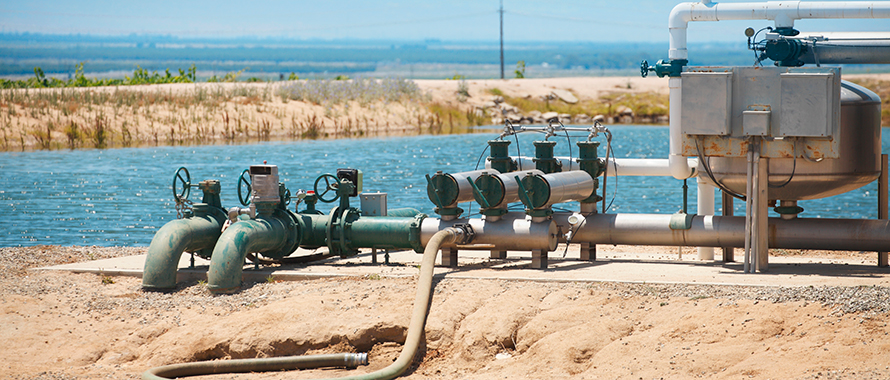A consulting firm will pay $1.75 million to settle claims of breach of contract and professional negligence related to the design and construction of a large, lined pond that was part of a $13 million water treatment plant. The Community Services District of Cambria, California sued the firm, CDM Smith, in 2018, claiming the pond required repairs, redesign and modifications that cost the district about $2.5 million.
The settlement, finalized on January 27, allows the District to seek reimbursement separately for “reasonable costs,” including legal fees that totaled about $250,000 by February 11.
The evaporation pond was built to handle brine discharge from the municipality’s Sustainable Water Facility. It was reportedly too small to effectively treat the water and was decommissioned in 2017 after a 1,000-year storm increased water levels above state limits.
“Sometimes certain scenarios are not taken into account in a design, or calculations are incorrect,” said Michael Muglia, National Underwriting Director, Professional Liability, Burns & Wilcox, Detroit/Farmington Hills, Michigan. “Oftentimes, it is the pre-planning on a job site that has the greatest impact on the final product,” he noted.
The situation illustrates the risks faced by consultants, architects, engineers and designers when they take on a project with the potential for costly errors as well as the need for Errors & Omissions (E&O) Insurance or Professional Liability Insurance to help mitigate those threats.
Larger projects, costlier mistakes
Mistakes can happen in any professional service, but those in the design and construction industry can be particularly costly, said Kenneth Labelle, Broker, Professional Liability, Burns & Wilcox Brokerage, Chicago, Illinois. “The bigger the project, the bigger the potential price tag to correct any errors,” he said.
If a serious design flaw is identified after work has been completed on a project, Labelle explained, a total rebuild could be needed. However, he cautioned, “minor mistakes and even delays in projects can cost millions.”
Other headline-grabbing cases bear this out. In February, a contractor was sued for $17.3 million by the government of Yukon, Canada, over construction of a 2,500-square-foot arena that was never completed.1 In 2018, an architectural firm in Ohio agreed to pay $1.6 million to settle a lawsuit over design issues at multiple school buildings. In the Ohio case, the district’s lawsuit reportedly named 2,314 “design errors and omissions” in the firm’s plans that led to 319 change orders.2
“Without the appropriate insurance, companies could be forced to pay the full cost of correcting these kinds of errors,” said Paula Lansky, Manager, Professional Liability, Burns & Wilcox, Toronto, Ontario. “The impact could be devastating.”
E&O Insurance and Professional Liability Insurance policies are tailored to the type of service being provided. Non-licensed professionals generally require E&O Insurance, while licensed professionals need Professional Liability Insurance. The coverage is essential for anyone involved in construction projects.
“Anyone in the construction life cycle, from design oversight and management, to engineering services and installation, needs this coverage,” Muglia said.
Determining whether errors made on a project are the result of negligence is a complex process, Lansky noted. Nevertheless, defending a lawsuit is a significant expense irrespective of whether negligence is determined to have taken place.

The fact is, if something goes wrong on a project, everyone with any involvement whatsoever is likely to be named in a lawsuit.
The potential for costly errors, along with rising jury awards3 and defense costs,4 make E&O Insurance essential for consulting firms and professionals. Lansky pointed out that project contracts will often not be awarded to a contractor lacking proof of E&O Insurance. “The fact is,” she said, “if something goes wrong on a project, everyone with any involvement whatsoever is likely to be named in a lawsuit.”
Unlike Professional Liability Insurance, which can include coverage for bodily injury and property damage expenses related to an error, E&O Insurance is specifically designed to help with the financial damage caused by a consultant’s mistake. “The damages could be enormous,” said Labelle. “If an error related to a consultant’s work on a technology product for a multibillion-dollar company has devastating effects on the business, it could result in a massive E&O Insurance claim.”
Understanding policy exclusions is vital
The impact of COVID-19 on the construction industry has been vast, including project delays and cancellations,5 staffing difficulties and job site coronavirus outbreaks.6 Material shortages have also been a problem, and the price of lumber has reportedly skyrocketed.7 While the industry has shown signs of a rebound in Canada8 and the U.S.,9 pandemic-related challenges remain and could influence E&O Insurance coverage considerations for consultants, designers and other professionals.
“Many construction companies experienced staff turnover as COVID-imposed site shutdowns furloughed workers,” Muglia said. “This could mean hiring independent contractors you have not previously worked with, once work resumes. That is why the definition of ‘insured’ is just one of the factors that should be considered in evaluating whether insurance coverage and exclusions are appropriate.”
E&O Insurance policies are nuanced and must be reviewed carefully, Muglia said. They generally cover a set of specified services and include a variety of exclusions. Firms that provide design and construction work, for example, should verify their E&O Insurance policy includes coverage for both services. Companies that utilize subcontractors or unlicensed professionals should confirm that these workers are insured parties under the terms outlined in their policies.
“A company’s insurance coverage should be tailored for its own liability as well as the subcontractors they are legally responsible for,” said Muglia.
This is a critical distinction, Labelle noted. “A certain incident may meet the criteria for a covered loss, and yet if a subcontractor is involved and the policy does not extend to independent contractors and subcontractors, there will likely be no coverage,” he said.
Other considerations include coverage for pollution-related costs — E&O Insurance policies typically do not include pollution, while Professional Liability Insurance policies typically do — along with covered territories and reporting periods.
A faulty workmanship provision could also be an important factor in Professional Liability Insurance policy coverage, if there is no flaw in a design but an error occurs during the execution of the build. “Faulty workmanship coverage can help with what it costs to redo the work,” Labelle said. While excluded from many policies, faulty workmanship coverage can be found in ProConstruct, an exclusive Burns & Wilcox Professional Liability Insurance program for construction and design professionals in the U.S.
In the event an error is discovered midway through a project, rectification expense coverage can help with the cost to correct it. This is key, since many policies require final delivery of a project before a claim can be made.
Expertise matters
Errors continue to pose considerable risks in the construction industry, even as technological advances improve design methods.10 A survey of construction leaders and decision-makers found that poor project data and miscommunication on projects caused 48 percent of all construction rework in the U.S., or an estimated total of $31.3 billion in 2018.11

Brokers specializing in construction know the markets offering appropriate coverage and what endorsements to ask for based on the operations and services a company provides. You do not want a generalist for this type of coverage.
Problems can also occur long after a project is completed, Labelle noted. To address this risk, companies can obtain an annually-renewed policy that insures their entire practice or a project-specific policy written for a single project and followed up with a “tail policy” that extends coverage for a set period of time after the project’s completion. “Specific, dedicated policies and limits for each project can be advantageous, particularly for large firms,” Labelle said.
Experienced brokers are essential to determine proper E&O and Professional Liability Insurance coverage, Muglia said. “Brokers specializing in construction know the markets offering appropriate coverage and what endorsements to ask for based on the operations and services a company provides. You do not want a generalist for this type of coverage.”
Lansky agreed, adding that how claims will be handled and the financial stability of the insurance company are other necessary considerations. “A knowledgeable underwriter who understands the risks and exposures is critical,” she said.
Although the E&O Insurance market is beginning to harden to some extent, the potential cost of going without insurance is far greater than any policy premium. “Its decisions regarding Professional Liability and E&O Insurance coverage are a reflection of how much risk a company wants to transfer rather than take on itself,” Lansky said.
Sources
1Hong, Jackie. “Yukon government files $17.3M lawsuit over Carmacks arena construction.” CBC, February 17, 2021. 2 Kelley, Jeremy P. “Architect pays $1.6 million to settle lawsuit over Dayton school flaws.” Dayton Daily News, April 17, 2018. 3 Bronstad, Amanda. “'Jurors Want to Punish': Why a Jury Verdict Goes 'Nuclear.’” Law.com, October 17, 2019. 4 Flinn, Tamara. “Litigation insights offer the key to rising claim costs.” Verisk, November 15, 2019. 5 “Coronavirus Has Caused Significant Construction Project Delays And Cancellations, Yet Demand For Skilled Labor Is High, New Survey Finds.” Associated General Contractors of America, September 2, 2020. 6 Goodman, Jenn; and Bousquin, Joe. “A roundup of coronavirus outbreaks on construction sites.” Construction Dive, November 19, 2020. 7 Blackwell, John Reid. “'It's been crazy:' Pandemic has sent lumber prices soaring, causing home construction costs to rise amid strong demand.” Richmond Times-Dispatch, December 11, 2020. 8 Harvey, Ian. “Canada’s construction sector took a COVID-19 hit then rebounded: survey.” Daily Commercial News by ConstructConnect, November 25, 2020. 9 Shultz, David. “COVID-19’s Uneven Hit—And Rebound—On the U.S. Construction Job Market.” Built: The Bluebeam Blog, November 2, 2020. 10 Lau, Wanda. “Nine Tech Strategies for Architects for 2019.” Architect Magazine, January 6, 2019. 11 Schott, Pete. “Construction Disconnected: The High Cost of Poor Data and Miscommunication [Report].” PlanGrid Blog, August 1, 2018.






